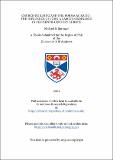Files in this item
Church building and the Forma ac ratio : the influence of John a Lasco's ordinance in sixteenth-century Europe
Item metadata
| dc.contributor.advisor | Pettegree, Andrew | |
| dc.contributor.author | Springer, Michael S. | |
| dc.coverage.spatial | viii, 267 p. | en_US |
| dc.date.accessioned | 2018-05-29T13:13:14Z | |
| dc.date.available | 2018-05-29T13:13:14Z | |
| dc.date.issued | 2004 | |
| dc.identifier.uri | https://hdl.handle.net/10023/13591 | |
| dc.description.abstract | Protestant church orders were a key tool for shaping belief and practice during the sixteenth century. These declarations of official religious policy were composed by both secular and ecclesiastical leaders, and reflected the shared interests of the church and state in managing evangelical reforms. Their constitutional nature and their role in articulating doctrine made them the most effective means for church building during the period. John a Lasco's Forma ac ratio was one of the most significant of these works. His text, which was published in 1555, provided a comprehensive blueprint for Protestant congregations. It also marked a pivotal point in the development of orders. Although the earlier documents varied widely in their form and scope, by the end of the century they had developed a common format and standard range of topics. The Forma ac ratio is one of the first to exhibit this trend, marking this crucial shift in the development of such works and setting the standard for the ordinances that followed. Although this text had much in common with other orders, it was distinguished by the reformer's unique vision for church organisation and ceremonies. The content reveals the various forces that shaped his ideas. For example, he modelled his ecclesiastical administration after the episcopacies found in the German lands. He added to this Zwingli's Eucharistic rite and Calvin's ecclesiastical discipline. This work also contained a Lasco's own innovative contributions including his emphasis on congregational authority. In addition, the ordinance included extensive commentary to explain, justify and defend the prescribed practices. This comprehensive nature set the Forma ac ratio apart from other orders. A Lasco's tome had a significant impact on Protestant congregations throughout Europe. Originally, he had written the work for the London Strangers' Church, which was comprised of religious refugees in England's capital city. These exiles played a key role in transmitting his ecclesiastical model, when they returned to the continent in the 1550s, they established new refugee congregations following the reformer's example. They later carried his innovative order to their native lands when they returned home in the subsequent decades. The Forma ac ratio's widespread impact across Europe makes it one of the key ordinances from the Reformation period. In addition, as this thesis demonstrates, it was these qualities - its function in church building, the innovative form, and the refugees' role in transmitting his model - that ensured its influence and significance in sixteenth-century Europe. | en_US |
| dc.language.iso | en | en_US |
| dc.publisher | University of St Andrews | |
| dc.subject.lcc | BV649.L3S7 | |
| dc.subject.lcsh | Łaski, Jan, 1499-1560 | |
| dc.subject.lcsh | Church orders, Protestant | en |
| dc.subject.lcsh | Europe--Church history--16th century | en |
| dc.title | Church building and the Forma ac ratio : the influence of John a Lasco's ordinance in sixteenth-century Europe | en_US |
| dc.type | Thesis | en_US |
| dc.type.qualificationlevel | Doctoral | en_US |
| dc.type.qualificationname | PhD Doctor of Philosophy | en_US |
| dc.publisher.institution | The University of St Andrews | en_US |
This item appears in the following Collection(s)
Items in the St Andrews Research Repository are protected by copyright, with all rights reserved, unless otherwise indicated.

